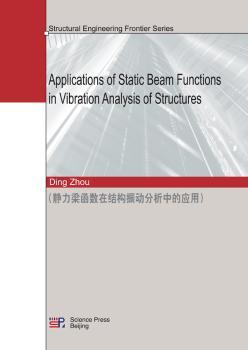内容简介
《Applications of Static Beam Functions in Vibration Analysis of Structures(静力梁函数在结构振动分析中的应用)》以的结构力学分析方法——李兹法为基础,创造性地提出了以静力梁函数作为基函数,研究梁、板结构的动力学特性,重点分析变截面和变厚度、内部支撑以及边界条件对梁、板结构振动特性的影响。全书共23章,第1章介绍李兹法的发展史与存在的问题;第2章至第6章研究各种边界和内部支撑条件下变截面欧拉-伯努利梁和铁摩辛柯梁的振动特性;第7章至第11章研究各种边界和线支条件下等厚度基尔霍夫薄板的振动特性;第12章至第14章研究线支和点支等厚度复合材料薄板的振动特性;第15章和第16章研究变厚度基尔霍夫薄板的振动特性;第17章至第20章研究等厚度和变厚度米德林中厚板的振动特性;第21章和第22章研究线支和点支等厚度复合材料厚板的振动特性;第23章研究矩形储液罐的流-固耦合振动特性。
《Applications of Static Beam Functions in Vibration Analysis of Structures(静力梁函数在结构振动分析中的应用)》可供航空航天、机械、土木和力学等方面的科研工作者、工程设计人员、大专院校有关专业教师和研究生使用。
目录
Preface
Chapter 1 Introduction
Chapter 2 Vibration Analysis of Tapered Euler-Bernoulli Beams
2.1 Introduction
2.2 The Rayleigh-Ritz Method for the Tapered Beams
2.3 A New Set of Admissible Functions
2.3.1 The coefficients for a truncated beam
2.3.2 The coefficients for a sharply ended beam
2.3.3 The tapered beam with rigid body motion
2.4 Convergency and Comparison Studies
2.4.1 Convergency study
2.4.2 Optimum expanding point of Taylor series
2.5 Numerical Results
2.6 Concluding Remarks
Chapter 3 Vibration Analysis of Tapered Euler-Bernoulli Beams with Intermediate Supports
3.1 Introduction
3.2 The Rayleigh-Ritz Method for Tapered Beams with Intermediate Supports
3.3 A Set of Static Tapered Beam Functions
3.3.1 The truncated beam
3.3.2 The sharply ended beam
3.3.3 The tapered beam with motions of rigid body
3.4 Numerical Examples
3.5 Concluding Remarks
Chapter 4 Vibration Analysis of Multi-span Timoshenke Beams
4.1 Introduction
4.2 Eigenfrequency Equation
4.3 Static Timoshenko Beam Functions
4.4 Convergence and Comparison Studies
4.5 Numerical Examples
4.6 Concluding Remarks
Chapter 5 Vibration Analysis of Tapered Timoshenke Beams
5.1 Introduction
5.2 Eigenfrequency Equation of Tapered Beam
5.3 The Static Timoshenko Beam Functions(STBF)
5.3.1 Truncated beam
5.3.2 Sharply ended beam
5.4 Convergence and Comparison Study
5.5 Numerical Results
5.6 Conclusions
Chapter 6 Estimation of Dynamic Characteristics of a Spring-Mass-Beam System
6.1 Introduction
6.2 Governing Differential Equations
6.3 Galerkin Solutions
6.4 Basic Characteristics of Solutions
6.5 Static Beam Functions
6.6 Determination of Factors
6.7 An Example
6.8 Characteristics of Solutions
6.9 Conclusions
Chapter 7 Vibration Analysis of Kirchhoff Rectangular Plates
Part I Using Static Beam Functions under Point Loads
7.1 Introduction
7.2 Sets of Static Beam Functions under Point Loads
7.3 Rayleigh-Ritz Solution for Rectangular Plates
7.4 Numerical Results
7.5 Concluding Remarks
Part II Using Static Beam Functions under Sinusoidal Loads
7.1 Introduction
7.2 The Set of Static Beam Functions
7.3 The Rayleigh-Ritz Approach
7.4 Numerical Results
7.5 Concluding Remarks
Chapter 8 Vibration Analysis of Kirchhoff Rectangular Plates with Elastic Edge Constraints
8.1 Introduction
8.2 The Set of Static Beam Functions
8.3 The Rayleigh-Ritz Solution
8.4 Numerical Examples
8.5 Discussion and Conclusions
Chapter 9 Vibration Analysis of Kirchhoff Rectangular Plates with Intermediate Line-supports
Part I Using a Combination of Vibrating Beam Functions and Polynomials
9.1 Introduction
9.2 Mathematical Model
9.3 Numerical Examples
9.4 Concluding Remarks
Part II Using the Static Beam Functions for Beam with Point-supports
9.1 Introduction摘要与插图
Chapter Introduction
It
is
well
known
that
beams
and
rectangular
plates
are
some
of
the
most
commonly
used
structural
elements
in
aerospace,
civil
and
marine
engineering.
Their
dynamic
behaviors
are
of
practical
importance
to
design
engineers.
In
the
practical
applications,
beams
and
rectangular
plates
are
either
uniform
or
non-uniform.
Sometimes,
internal
point-supports
or
line-supports
may
be
placed
to
reduce
the
magnitude
of
displacements
and
stresses
of
the
structures
or
to
satisfy
special
architectural
and
functional
requirements.
In
general,
the
Euler-Bernoulli
beam
theory
(Gor




 VIP会员
VIP会员